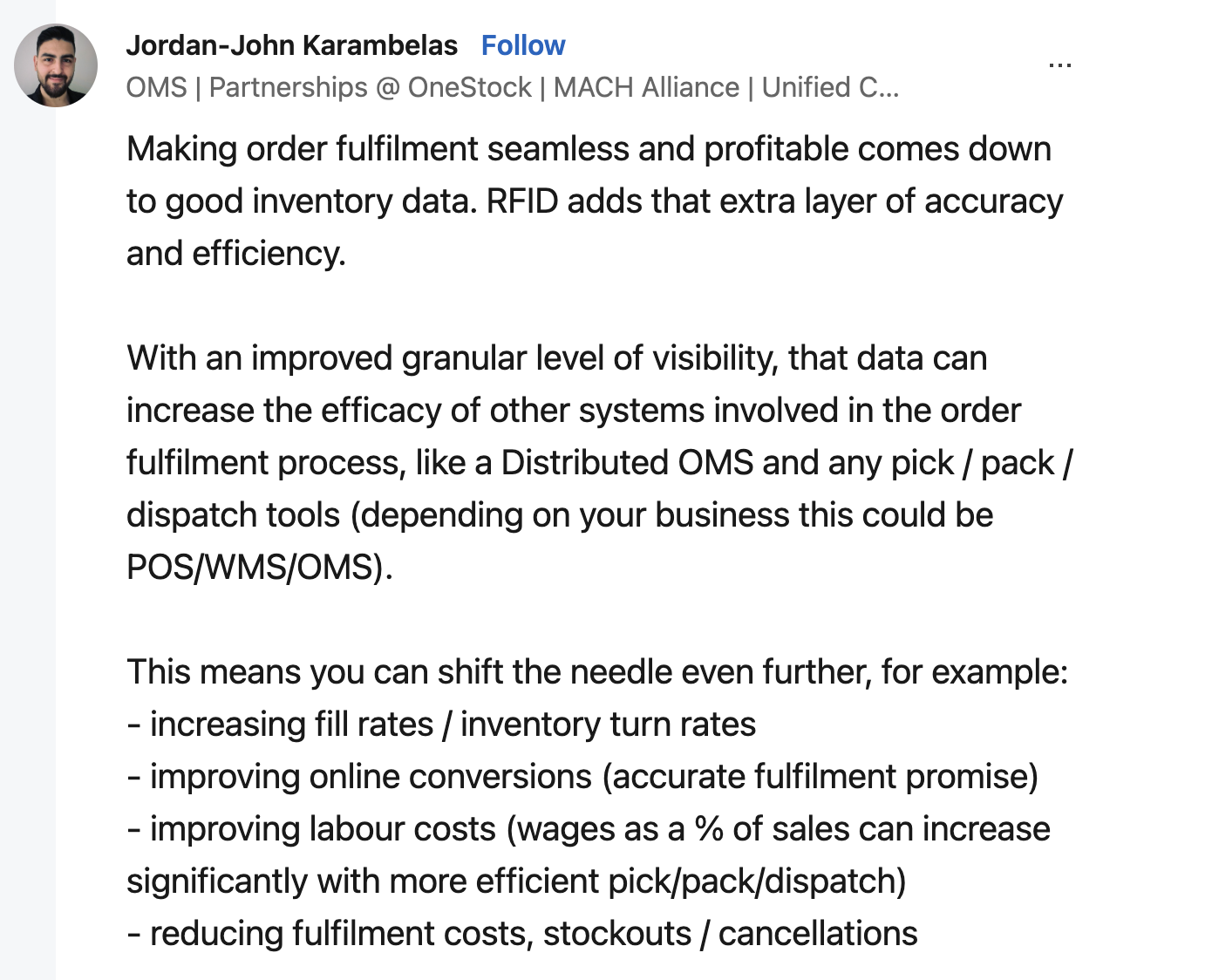Package Puzzles: Logistical challenges are causing delivery delays, frequent stockouts, and an increase in returned items, reaching levels never seen before.
Supply Chain Strain: The strain on supply chains is exacerbating issues, impacting businesses' ability to meet consumer demand effectively and timely.
Consumer Conundrums: Customers face heightened frustration as they encounter more frequent delays and unavailable products, leading to increased dissatisfaction.
Supply Chain Chaos: Current supply chain issues are causing significant problems with delivery delays and stockouts, impacting the availability of products for consumers everywhere.
Returns on the Rise: The number of product returns is surging, adding to the logistical challenges faced by businesses in managing their supply chains effectively.
Delivery delays. Stockouts. Returned items. They’re at an all-time high.
These may be sources of frustration for you, but they’re also a big letdown for customers who trusted you at order placement.
And I’m sure you already know, but they’re a hard crowd to please.
A PWC survey showed that one wrong move can turn off 32% of loyal customers. Yikes.
If you’re tired of these obstacles crippling your business, improving order management should take priority.
So drop whatever it is you’re doing, and dive in—we have some work to do:
The Biggest Order Management Bottlenecks (& How to Fix Them)

First, let's look at how these obstacles arise and what you can do to keep them at bay:
Slow, manual order processing creates delays
Considering the digital age we live in, it’s astonishing to hear that over 40% of surveyed workers still spend a quarter of their time on manual, repetitive tasks.
For some brands, manual processes may feel like the only option due to insufficient or disjointed systems, but is it worth the time sink?
Let’s focus on one step, say order approval, and see what you think.
In a manual setup, an employee checks the order details and then sends it off to the appropriate team, who then signs off on the order before notifying warehouse staff to prepare the items.
Sounds like it can take a long time to complete, right? If there’s missing information or errors, you can
expect more back-and-forth.
With automated systems, the process is almost instant. Tools like an order management system (OMS), such as Cin7, can validate customer orders in seconds by analyzing readily available pricing, inventory, and customer details.
Let’s look at how Cin7 has helped Canadian jewelry brand Dean Davidson streamline order processing:
Dean Davidson initially handled various processes manually, including filling in addresses for every order entry. It was fine at the beginning. But when sales skyrocketed to five times their initial revenue, they knew they needed help.
Cin7’s automations eliminated manual data entry and reporting, saving them more than CA$55,000 in labor.
Source: Cin7
Check out other OMS options to eliminate manual work and boost operational efficiency:
Inventory inaccuracies lead to stockouts and overstocking
Poor inventory tracking leads to overselling, stockouts, or excess stock—all of which can drain your resources.
Research suggests that the average inventory accuracy sits between 65% and 91%.
That’s a wide discrepancy. If you want to land on the higher end of that range, you need the right inventory management system with features such as:
- Real-time inventory tracking
- Automated stock level alerts
- AI-powered demand forecasting
- Integrations with existing software
In fact, with the help of Linnworks, SourceBMX, an online store for all things BMX, was able to achieve 100% accuracy—all while expanding operations.
They used the tool to migrate all inventory and product data, and it did flawlessly—no downtime. Linnworks and their implementation team helped the company clean up their data to make sure they see accurate, real-time information moving forward.
Source: Linnworks
Here are the top inventory management solutions to optimize your inventory:
Shipping delays and fulfillment errors frustrate customers
A poor delivery experience damages your brand. Descartes research showed that:
- 23% of consumers don't plan to order again
- 21% no longer trusted the retailer
- 16% told friends and families to avoid the retailer after a bad delivery experience
Common causes for order fulfillment delays and errors are inefficient order routing, picking/packing mistakes, and slow warehouse processes.
Here are some ways you can ensure you're delivering the right products to your customers within the promised window:
Barcode scanning and automated order validation have also been crucial in reducing picking and packing mistakes.
And finally, a simple but effective approach is adding a quality control checkpoint before dispatch to catch any last-minute errors.
Lack of real-time order tracking increases customer inquiries
One in every five customer support tickets is a “where is my order” (WISMO) query.
Why? Because modern customers expect delivery transparency. It’s part of creating an exceptional customer experience.
If you’re not keeping them in the loop, they’ll find a way to get the information—be it via email, chat, phone, or whatever customer communication channel you use.
If they have to do it several times, they will.
To provide real-time transparency, you need real-time visibility.
Enter: Order tracking software.
ShippyPro, for example, has features like track-and-trace that enable you to:
- Get up-to-the-minute information on your deliveries in a few clicks
- Create and send branded updates that you can send via email, WhatsApp, and SMS
- Design a branded tracking page for your customers.
All these can help brands reduce WISMO queries, strengthen customer relationships, and improve repeat business.
Discover top order tracking solutions here:
Returns and reverse logistics are inefficient and costly
Returns are inevitable. When asked if they had returned an item in the past six months, seven in 10 people said yes.
What does this mean for your business?
In 2024, the retail industry estimated that 16.9% of sales would be returned. Not only will you be earning less than your expected revenue, you also have to bear the costs associated with the return process.
Having a well-defined returns policy and reverse logistics strategy can help maintain a healthy supply chain while protecting your bottom line. Here’s a solid guide on ecommerce returns best practices.
7 High-Impact Strategies to Improve Order Management Today
I’ve given you a sneak peek at key strategies to fight off those seemingly hard-to-beat order management enemies.
In this section, I’ll show you how you can put these tips into action.
Automate order processing with smart workflows
The number of order management workflows you can create with your OMS gives you flexibility, efficiency, and scalability.
Advanced OMS software, like Linnworks, come with rule-based automation, where you set guidelines for what actions the software should perform based on specific criteria or parameters.
Think: “if this, then that”.
Let’s have a closer look at Linnworks’ Rule Engine. The flowchart below shows order parameters used to select the appropriate shipper or carrier.

As you can see, every rule has a corresponding action. Here are other examples of tasks you can do with Linnworks:
- Attaching tags to orders for easy identification
- Managing orders to the appropriate warehouse for maximum efficiency
- Determining how to pack orders to minimize waste
Automated workflows get rid of guesswork, reducing error rates and labor requirements.
Improve demand forecasting with AI and predictive analytics
If you could blame one thing for your stockouts and overstocking, it would be poor forecasting.
Forecasting has always been common practice, but most businesses rely on rigid formulas.
Newer tools offer adaptability that can help you ride market fluctuations, industry shifts, and changing customer behavior.
According to Cin7’s CEO Ajoy Krishnamoorthy:
Inventory management and AI-forecasting systems accurately forecast demand months in advance, maintaining inventory levels and eliminating the risk for significant profit losses.
Cin7’s Foresight AI uses sophisticated machine learning to factor in seasonality, sales history, and stockout trends.
This feature also weeds out extreme cases, like sales that are unlikely to happen again, so you end up with an optimal safety stock.
Krishnamoorthy added, “Not only does it help brands achieve over 99% product availability, it also frees up to 20% of inventory capital and saves valuable time through automated, streamlined operations.”
Reduce delivery times and costs with smart shipping strategies
One quick way to speed up delivery times? Review your shipping strategies and your suppliers’ performance.
Make sure you choose reliable partners wisely.
“Effective communication is key when selecting carriers and third-party logistics (3PL) providers. We consider these partners extensions of our team, who must be reliable in their tracking and timely deliveries,” shared Josef Friedman, director of operations at Kisco Candles.
For shipping strategies, try:
- Zone skipping: Shipping zones bump up the fees you pay for. You can get around them by partnering with regional 3PLs/fulfillment centers.
- Efficient packaging: Bulky or oversized boxes get charged more, even if they’re light. Avoid unnecessary packaging to keep costs down.
- Optimized last-mile delivery strategy: The final stretch of delivery is often the costliest. Micro-fulfillment centers can reduce last-mile distance, or offer pick-up points to get around this part.
For more tips on improving your shipping process, read this blog post.
Optimize warehouse and fulfillment center routing
Shipping delays often result from inefficient fulfillment center selection.
Strategically located warehouses can save you shipping time and reduce shipping costs.
If you already have reliable providers in your roster, knowing who to tap for a delivery is important.
Intelligent order routing systems help you hit the nail on the head when identifying the best-fit provider for the job. You set the rules, and the system takes over.
For example:
Dynamic carrier selection tools can automatically choose the best carrier for each package based on cost, speed, and reliability, which is critical for balancing your margins and meeting customer expectations.
Ben Emmrich, CEO of Tusk Logistics
Implement barcode scanning and RFID for accuracy
Take a look at your customer complaints. Are you seeing many fulfillment errors?
If so, you’ll need to put your picking and packing methods under the microscope. This stage of the fulfillment process is prone to order errors and missing inventory.
To turn things around, rely on tools to optimize your warehouse like:
Barcode scanning
This might have been around for more than 50 years, but it’s still one of the most reliable methods out there.
Each barcode is unique to the product variant it represents, making it easier to track products and reduce errors during the picking and packing stages.
Learn how to install a barcode inventory system here.
RFID tracking
RFID tags and readers take barcode technology to the next level.
Since, RFID has a wider read range, it provides more granular data so you can spot inconsistencies more quickly. Therefore, it’s great for batch picking and overall SKU management.
Here are some more insights from a pro:

Streamline returns and reverse logistics
The more complicated your return process is, the longer your resale cycle.
To secure your stocks as soon as possible and turn them into profit, you need a more well-structured reverse logistics strategy.
Let’s take a look at how fashion giant Mango handles returns. If you’ve ever returned an item from them, you know how quickly everything flows.
Here’s what they’ve put in place:
- Self-service return portals for convenience. Mango’s app allows customers to process returns directly.
- Multiple return options for flexibility. On the app, you can choose from: in-store, pick-up point, or on-demand pickup.
- Prepaid return labels for hassle-free logistics. All online purchases come with a return label and form. If lost, you can get it from the app.
Offer similar convenient solutions to your customers for a faster handover.
You can also automate refund approvals using tools like Rich Returns, while tools like Returnalyze help you read between the lines of your return patterns, allowing you to reduce their occurrence over time.
Continuously track and optimize order management KPIs
Order accuracy, fulfillment speed, or inventory turnover—these are some metrics to consider to continuously improve your order management strategy.
Of course, the KPIs you choose should match your goals, whether they are reducing shipping errors, improving fulfillment speed, or reducing return rates.
Order management software provides real-time dashboards to help you keep an eagle eye on your target KPIs.
For example, Salesforce Commerce Cloud, shows you order milestone status and trends like delayed orders and failed orders:

Say Bye To Your Order Management Inefficiencies
Timely delivery. Lean inventory. Low return rates.
How do these sound? Like music to your ears, probably.
You can achieve them (and more!) when you improve your entire order management process. Implement these 7 high-impact strategies alongside the right software solutions, and watch your operations transform.
Want to know more? Satisfy your thirst for learning with this useful guide: Distributed Order Management (DOM): The Ultimate Guide to Smarter, Faster Fulfillment
Retail never stands still—and neither should you. Subscribe to our newsletter for the latest insights, strategies, and career resources from top retail leaders shaping the industry.




